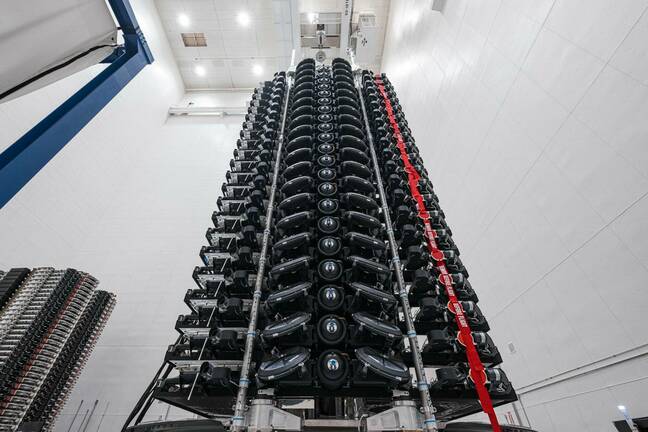SpaceX Lobs Second-gen Starlink Satellites Into Orbit
Starlink has sent the first batch of its second-generation satellites into orbit today, but not the full-sized hardware CEO Elon Musk promised last year.
Instead of the seven-metre-long, 1.25 ton Starlink 2 orbiters Musk claimed wouldn't be launched until the company's Starship vessel managed to do more than explode on the launchpad, SpaceX indicated in a series of tweets that the "V2 mini" is en route to orbit today aboard the company's workhorse Falcon 9 rocket.
Deployment of 21 Starlink V2 Mini satellites confirmed— SpaceX (@SpaceX) February 28, 2023
As we noted previously, a Falcon 9 or a Falcon 9 heavy is capable of carrying full-sized Starlink 2 satellites into orbit – but not many of them. Using either Falcon limited to haul the gargantuan sats would not be economically viable.
A single Falcon 9 can hoist 21 V2 Minis. That's still far fewer than the 60 or so first generation Starlink satellites that could fly on a Falcon's back. But SpaceX claims [PDF] the V2 Mini is more capable than its first-gen sats, offering "four times the capacity for serving users compared to its earlier counterparts." Twenty-one V2 Minis should therefore deliver more bandwidth per launch.
Based on the limited information SpaceX has shared about the V2 Mini, it isn't possible to determine its exact size.
However SpaceX's legal filings and Falcon 9's known cargo capacity offer some clues.
In an October 2022 FCC filing [PDF], SpaceX shared a table of Gen 2 satellite dimensions, one of which was for a satellite named "F9-2" that weighs around 800 kilograms. You could pack 21 of those in a Falcon 9 and be only a few thousand kilos short of the maximum payload.
- Ground equipment failure scrubs latest ISS SpaceX launch
- Chinese defence boffins ponder microwaving Starlink satellites to stop surveillance
- Starlink performance sees a bump, and so do prices
- Starlink tempts users with $200 Global Roaming service
If F9-2 and the V2 Mini are the same craft, the Mini is still quite large – with twin solar arrays each measuring 52.5 square metres (565 sq ft) and a four metre long body.
According to Starlink's tweets, V2 Mini satellites include a "more powerful phased array antennas as the use of E-band for backhaul" and argon thrusters for orbital maneuvering. Other innovations seem focused on eliminating the light pollution complaints the company has faced from its network of over 3,500 satellites currently in orbit.
- Ground equipment failure scrubs latest ISS SpaceX launch
- Starlink tempts users with $200 Global Roaming service
- SpaceX threatened with $175,000 fine for Starlink crash risk paperwork blunder
- Smile! South Korea's moon orbiter sends back first snaps of Earth
Similar to the technologies Musk alleged would be in full-sized Starlink 2 sats, SpaceX said V2 Minis would reduce light pollution through a combination of in-house designed dielectric mirror film and low-reflectivity black paint. "Additionally, we've designed our solar arrays to allow off-pointing to reduce reflections as a satellite approaches the terminator."
If not Starship, please launch something
Starlink received permission in December to launch a new constellation of 7,500 second-generation Starlink satellites – more than twice the number the company currently has in orbit.
SpaceX's network performance has declined as its subscriber count has increased, and a performance bump between Q3 and Q4 of last year still wasn't enough to bring it to its 2021 performance peak.
Whether the launch of 21 V2 Minis will pave the way for better network performance is unclear, as is when Starship will actually manage to make it to orbit in order to deliver some of SpaceX's largest and most capable broadband satellites.
SpaceX said it's planning to make an orbital test launch of Starship as early as March. If successful, it would mean Starship is just two years behind the company's goal of landing the craft on the Moon before 2022.
With extra design time for the full-sized Starlink 2 satellites in front of it, SpaceX may want to consider outfitting its new hardware with defensive equipment. Chinese researchers have argued in a paper that China needs its own low-orbit broadband satellite constellation as soon as possible, and that it needs to be able to deter Starlink satellites outfitted with spy capabilities.
The solution, say the Chinese boffins, is to outfit their own satellites with microwave or laser weapons to disable Starlink orbiters without creating additional debris. We note that China has not always taken this position on reducing space garbage.
Russia has also threatened to declare Starlink satellites legitimate military targets over the service's use in Ukraine – a threat on which it may have the ability to follow through. ®
Google Leverages AI To Automatically Lock Phones During Theft
Amid increasing incidents of mobile phone thefts, Google has launched an AI-based feature that automatically locks the s... Read more
Microsofts Emissions Surge Nearly 30% Amid AI Demand Growth
Microsoft has reported a nearly 30% increase in its emissions from 2020 to 2023, underscoring the challenges the tech gi... Read more
Impact Of AWS Leadership Change On The Global AI Race
The recent leadership transition at Amazon Web Services (AWS), with Adam Selipsky stepping down and Matt Garman taking t... Read more
The Global Impact Of App Stores On Technology And Economy
Since Apple launched its App Store in 2008, app stores have become a central feature of the digital landscape, reshaping... Read more
Alibaba's Cloud Investment Strategy: Fuelling AI Innovation And Growth
Alibaba Group's cloud business, Alibaba Cloud, has emerged as a powerhouse in the tech industry, spearheading innovation... Read more
Elon Musk Takes On Government 'Censorship': A Clash Of Titans In The Digital Arena
Elon Musk's recent endeavors to challenge government-led content takedowns mark a significant development in the ongoing... Read more


